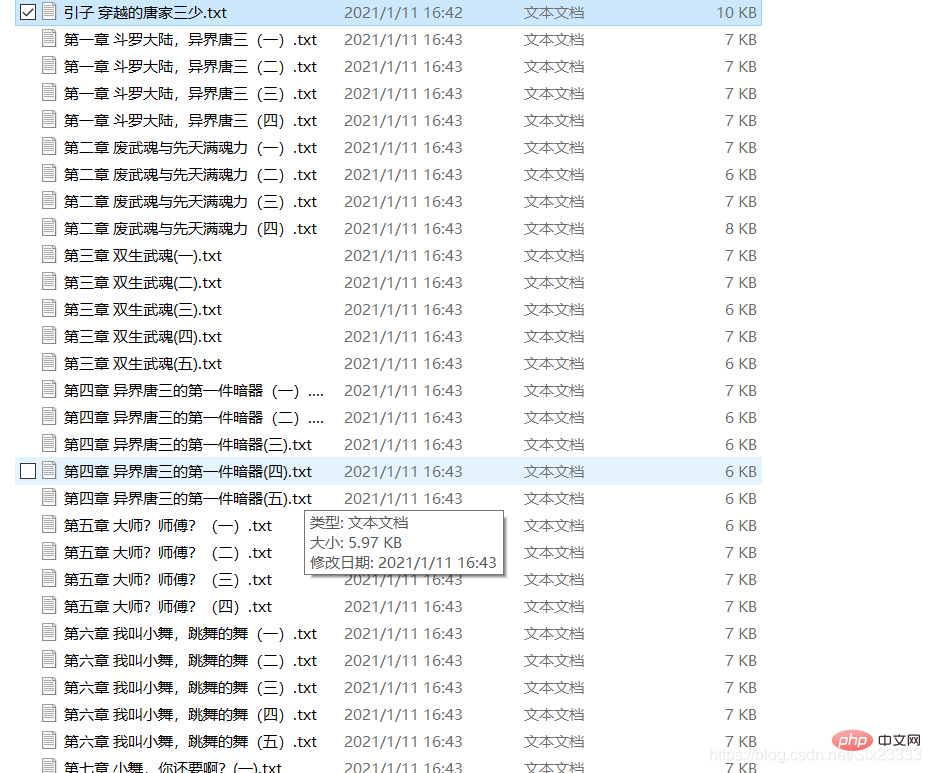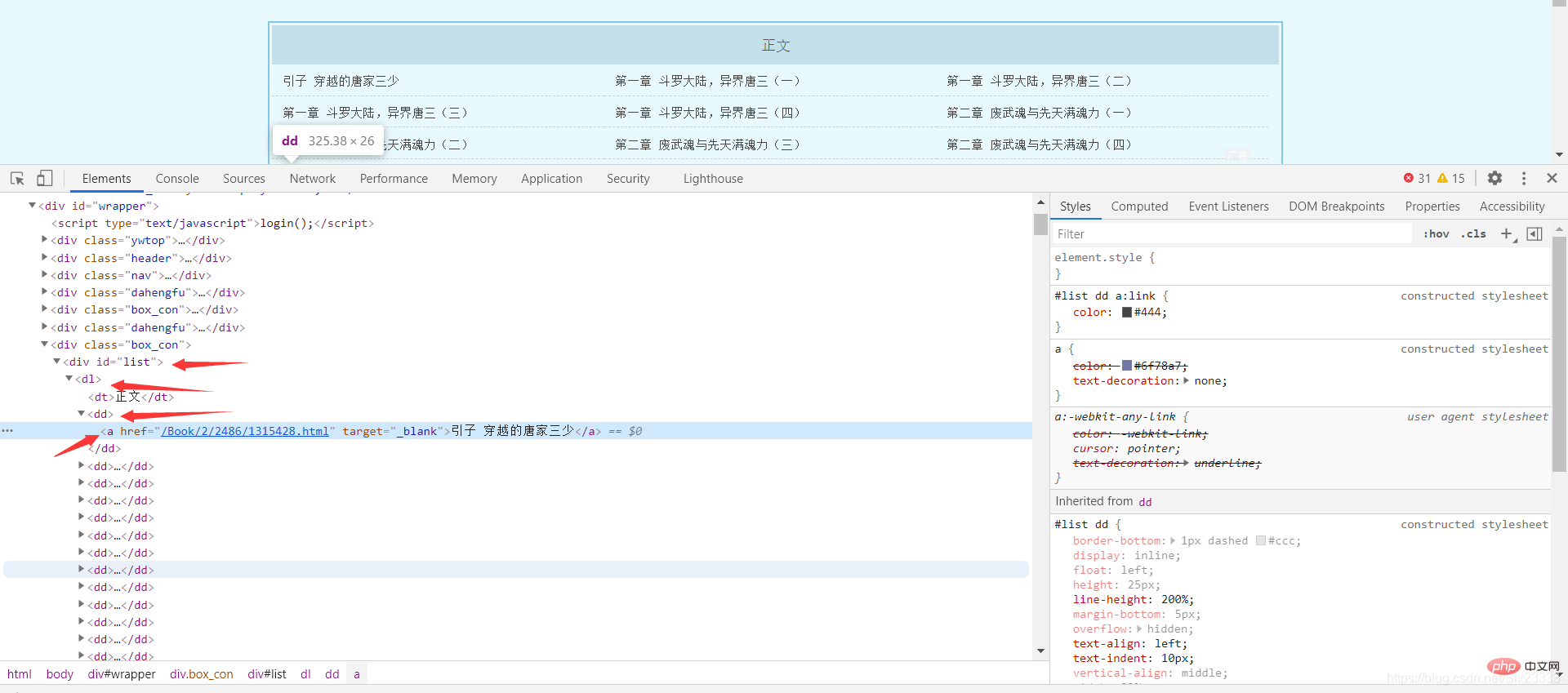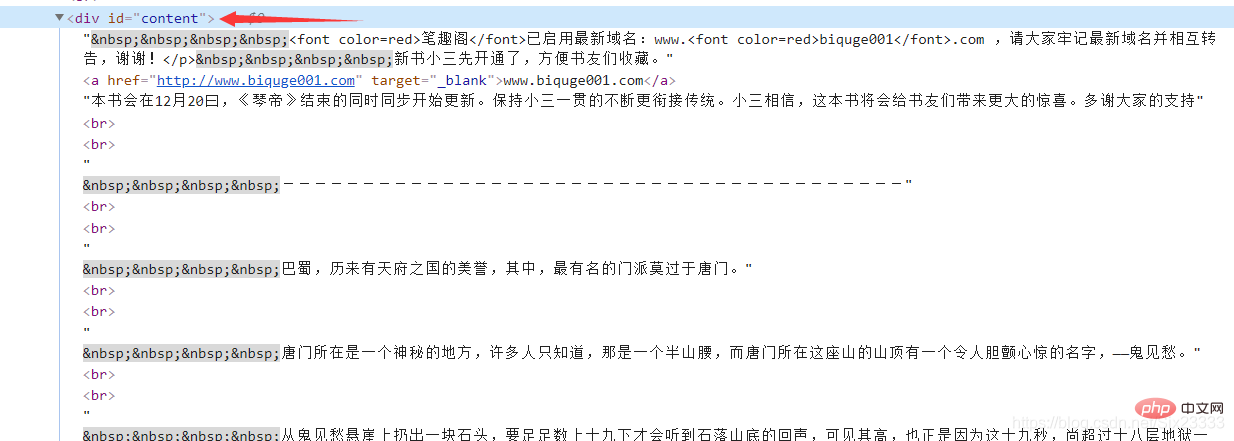 Backend Development
Backend Development
 Python Tutorial
Python Tutorial
 Introducing 60 lines of python code to write a simple Biquge crawler
Introducing 60 lines of python code to write a simple Biquge crawler
Introducing 60 lines of python code to write a simple Biquge crawler

推荐(免费):Python视频教程
文章目录
- 系列文章目录
- 前言
- 一、网页解析
- 二、代码填写
- 1.获取Html及写入方法
- 2.其余代码
- 总结
前言
利用python写一个简单的笔趣阁爬虫,根据输入的小说网址爬取整个小说并保存到txt文件。爬虫用到了BeautifulSoup库的select方法
结果如图所示:
本文只用于学习爬虫
一、网页解析
这里以斗罗大陆小说为例 网址:
http://www.biquge001.com/Book/2/2486/
可以发现每章的网页地址和章节名都放在了 中的a标签中,所以利用BeautfulSoup中的select方法可以得到网址和章节名
Tag = BeautifulSoup(getHtmlText(url), "html.parser") #这里的getHtmlText是自己写的获取html的方法urls = Tag.select("p #list dl dd a")然后遍历列表
for url in urls: href = "http://www.biquge001.com/" + url['href'] # 字符串的拼接 拼接成正确的网址 pageName = url.text # 每章的章名
然后每章小说的内容都存放在

substance = Tag.select("p #content") # 文章的内容最后同理在首页获取小说的名称

bookName = Tag.select("p #info h1")
二、代码填写
1.获取Html及写入方法
def getHtmlText(url): r = requests.get(url, headers=headers) r.encoding = r.apparent_encoding # 编码转换 r.raise_for_status() return r.textdef writeIntoTxt(filename, content): with open(filename, "w", encoding="utf-8") as f: f.write(content) f.close() print(filename + "已完成")
2.其余代码
代码如下(示例):
url = "http://www.biquge001.com/Book/2/2486/"substanceStr = ""bookName1 = ""html = getHtmlText(url)# 判断是否存在这个文件Tag = BeautifulSoup(getHtmlText(url), "html.parser")urls = Tag.select("p #list dl dd a")bookName = Tag.select("p #info h1")for i in bookName:
bookName1 = i.textif not os.path.exists(bookName1):
os.mkdir(bookName1)
print(bookName1 + "创建完成")else:
print("文件已创建")for url in urls:
href = "http://www.biquge001.com/" + url['href'] # 字符串的拼接 拼接成正确的网址
pageName = url.text # 每章的章名
path = bookName1 + "\\" # 路径
fileName = path + url.text + ".txt" # 文件名 = 路径 + 章节名 + ".txt"
Tag = BeautifulSoup(getHtmlText(href), "html.parser") # 解析每张的网页
substance = Tag.select("p #content") # 文章的内容
for i in substance:
substanceStr = i.text
writeIntoTxt(fileName, substanceStr)
time.sleep(1)
总结
简单利用了BeautfulSoup的select方法对笔趣阁的网页进行了爬取
更多相关学习敬请关注Python教程栏目!
The above is the detailed content of Introducing 60 lines of python code to write a simple Biquge crawler. For more information, please follow other related articles on the PHP Chinese website!

Hot AI Tools

Undresser.AI Undress
AI-powered app for creating realistic nude photos

AI Clothes Remover
Online AI tool for removing clothes from photos.

Undress AI Tool
Undress images for free

Clothoff.io
AI clothes remover

AI Hentai Generator
Generate AI Hentai for free.

Hot Article

Hot Tools

Notepad++7.3.1
Easy-to-use and free code editor

SublimeText3 Chinese version
Chinese version, very easy to use

Zend Studio 13.0.1
Powerful PHP integrated development environment

Dreamweaver CS6
Visual web development tools

SublimeText3 Mac version
God-level code editing software (SublimeText3)

Hot Topics
 1378
1378
 52
52
 How to solve the permissions problem encountered when viewing Python version in Linux terminal?
Apr 01, 2025 pm 05:09 PM
How to solve the permissions problem encountered when viewing Python version in Linux terminal?
Apr 01, 2025 pm 05:09 PM
Solution to permission issues when viewing Python version in Linux terminal When you try to view Python version in Linux terminal, enter python...
 How to efficiently copy the entire column of one DataFrame into another DataFrame with different structures in Python?
Apr 01, 2025 pm 11:15 PM
How to efficiently copy the entire column of one DataFrame into another DataFrame with different structures in Python?
Apr 01, 2025 pm 11:15 PM
When using Python's pandas library, how to copy whole columns between two DataFrames with different structures is a common problem. Suppose we have two Dats...
 How to teach computer novice programming basics in project and problem-driven methods within 10 hours?
Apr 02, 2025 am 07:18 AM
How to teach computer novice programming basics in project and problem-driven methods within 10 hours?
Apr 02, 2025 am 07:18 AM
How to teach computer novice programming basics within 10 hours? If you only have 10 hours to teach computer novice some programming knowledge, what would you choose to teach...
 How to avoid being detected by the browser when using Fiddler Everywhere for man-in-the-middle reading?
Apr 02, 2025 am 07:15 AM
How to avoid being detected by the browser when using Fiddler Everywhere for man-in-the-middle reading?
Apr 02, 2025 am 07:15 AM
How to avoid being detected when using FiddlerEverywhere for man-in-the-middle readings When you use FiddlerEverywhere...
 What are regular expressions?
Mar 20, 2025 pm 06:25 PM
What are regular expressions?
Mar 20, 2025 pm 06:25 PM
Regular expressions are powerful tools for pattern matching and text manipulation in programming, enhancing efficiency in text processing across various applications.
 How does Uvicorn continuously listen for HTTP requests without serving_forever()?
Apr 01, 2025 pm 10:51 PM
How does Uvicorn continuously listen for HTTP requests without serving_forever()?
Apr 01, 2025 pm 10:51 PM
How does Uvicorn continuously listen for HTTP requests? Uvicorn is a lightweight web server based on ASGI. One of its core functions is to listen for HTTP requests and proceed...
 How to dynamically create an object through a string and call its methods in Python?
Apr 01, 2025 pm 11:18 PM
How to dynamically create an object through a string and call its methods in Python?
Apr 01, 2025 pm 11:18 PM
In Python, how to dynamically create an object through a string and call its methods? This is a common programming requirement, especially if it needs to be configured or run...
 What are some popular Python libraries and their uses?
Mar 21, 2025 pm 06:46 PM
What are some popular Python libraries and their uses?
Mar 21, 2025 pm 06:46 PM
The article discusses popular Python libraries like NumPy, Pandas, Matplotlib, Scikit-learn, TensorFlow, Django, Flask, and Requests, detailing their uses in scientific computing, data analysis, visualization, machine learning, web development, and H



